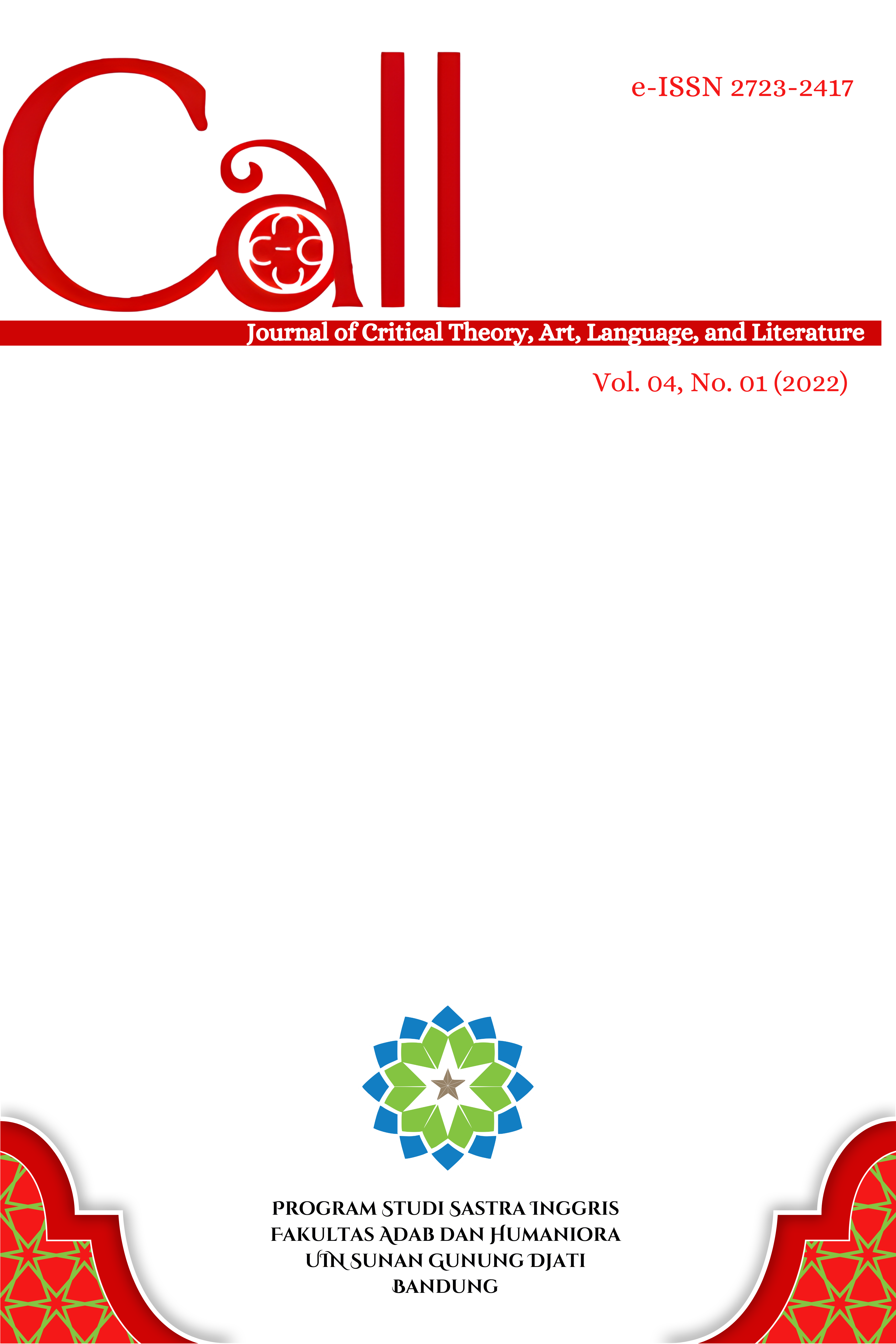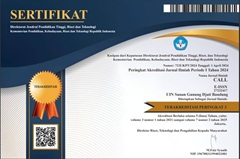SPEECH ABNORMALITY OF THE SCHIZOPHRENIC MAIN CHARACTER IN FRACTURED MOVIE
DOI:
https://doi.org/10.15575/call.v4i1.17496Abstract
One major difficulty of a person with schizophrenia is the ability to communicate and express his or her thought just like the common people due to several symptoms, such as hallucinations and delusions. It may result in various type of speech abnormalities. This study aims to present a comprehensive description on the types of speech abnormality of the schizophrenic main character in Fractured movie. It is based on the assumption that Ray Monroe as the main character has represented the schizophrenic speech abnormalities. Employing a descriptive qualitative research design, this study took the data from Ray Monroe's utterances transcribed from the movie, then analyzed them using the framework of Liddle et al. and Covintong et al. to describe how the speech abnormality appears. The findings indicated that of the schizophrenic's utterances cover eight types of speech abnormality. These included weakening of the purpose, looseness, strange logic, strange sentences, concept preservation, and distractibility. The positive and negative symptoms of schizophrenia, which have an impact on thought, language, and emotion, are the two main symptoms that create the speech abnormalities. When Ray Monroe made a claim using illogical language and without supporting evidence based on reality and developed odd logic.
Â
Keywords: psycholinguistics, schizophrenia, speech abnormality
References
Adwas, A. A., Jbireal, J. M., & Azab, A. E. (2019). Anxiety: Insights into Signs, Symptoms, Etiology, Pathophysiology, and Treatment. East African Scholars Journal of Medical Sciences, 2(October), 80–91.
Agustina, F. D. (2014) A Psycholinguistic Analysis of Schizophrenic Speech and
Behaviour Portrayed in the Main Character in Canvas Movie. Study Program English Education Department, Faculty of Language and Arts, Yogyakarta State University.
Astuti, A. W. (2014). A Psycholinguistics Analysis of Schizophrenic
Conversations Of The Main Character In The Uninvited Movie. English Language and Literature Study Program. English Education Department. Language and Arts Faculty. Yogyakarta State University.
Babicz-Zielinska, E., Wadolowska, L., & Tomaszewski, D. (2013). Eating disorders: Problems of contemporary civilisation - A review. Polish Journal of Food and Nutrition Sciences, 63(3), 133–146. https://doi.org/10.2478/v10222-012-0078-0
Balamurugan, K. (2018). Introduction to Psycholinguistics—A Review. Studies in Linguistics and Literature, 2(2), 110. https://doi.org/10.22158/sll.v2n2p110
Beck, A. T., & Rector, N. A. (2005). Cognitive approaches to schizophrenia: Theory and therapy. Annual Review of Clinical Psychology, 1, 577–606. https://doi.org/10.1146/annurev.clinpsy.1.102803.144205
Brown, M., & Kuperberg, G. R. (2015). A hierarchical generative framework of
language processing: Linking language perception, interpretation, and production abnormalities in schizophrenia. Frontiers in Human Neuroscience, 9(NOV), 1–23. https://doi.org/10.3389/fnhum.2015.00643
Chan, V. (2017). Schizophrenia and Psychosis: Diagnosis, Current Research Trends, and Model Treatment Approaches with Implications for Transitional Age Youth. Child and Adolescent Psychiatric Clinics of North America, 26(2), 341–366. https://doi.org/10.1016/j.chc.2016.12.014
Covington, M. A., He, C., Brown, C., Naçi, L., McClain, J. T., Fjordbak, B. S., Semple, J., & Brown, J. (2005). Schizophrenia and the structure of language: The linguist's view. Schizophrenia Research, 77(1), 85–98. https://doi.org/10.1016/j.schres.2005.01.016
De Boer, J. N., van Hoogdalem, M., Mandl, R. C. W., Brummelman, J., Voppel, A. E., Begemann, M. J. H., van Dellen, E., Wijnen, F. N. K., & Sommer, I. E. C. (2020). Language in schizophrenia: relation with diagnosis, symptomatology and white matter tracts. Npj Schizophrenia, 6(1), 1–10. https://doi.org/10.1038/s41537-020-0099-3
De Boer, Janna N., Brederoo, S. G., Voppel, A. E., & Sommer, I. E. C. (2020). Anomalies in language as a biomarker for schizophrenia. Current Opinion in Psychiatry, 33(3), 212–218.https://doi.org/10.1097/YCO.0000000000000595
Dogra, N., & Cooper, S. (2017). Defining mental health and mental illness. Psychiatry by Ten Teachers, Second Edition, January 2009, 1–11. https://doi.org/10.1201/9781315380612
Gofur. (2015). Schizofrenia on the Main Character of the Shutter Island Film based on Sigmund Frued's Psychoanalysis Theory. English Letters Department. Faculty of Adab and Humanities UIN Syarif Hidayatullah Jakarta
Hasanah, I. (2020). Speech Abnormality of The Schizophrenic Character in
Middle School: The Worst Years of My Lifre Movie. Department of English Literature. Faculty of Humanities. UIN Maulana Malik Ibrahim Malang
Jurenec, G. (2017). The Phenomenological Experience of Schizophrenia and Affective Function. Acta Psychopathologica, 03(05), 1–4. https://doi.org/10.4172/2469-6676.100139
Kuperberg, G. R. (2010). Language in Schizophrenia Part 2: What Can Psycholinguistics Bring to the Study of Schizophrenia and Vice Versa? Linguistics and Language Compass, 4(8), 590–604. https://doi.org/10.1111/j.1749-818X.2010.00217.x
Layer, K.; Khan, Z. (2015). Depression – A Review Review Paper Depression – A Review. Research Journal and Recent Sciences, 1(4), 79–87.
Liddle, P. F., Ngan, E. T. C., Caissie, S. L., Anderson, C. M., Bates, A. T., Quested, D. J., White, R., & Weg, R. (2002). Thought and language index: An instrument for assessing thought and language in schizophrenia. British Journal of Psychiatry, 181, 326–330. https://doi.org/10.1192/bjp.181.4.326
Lopez-Castroman, J., Leiva-Murillo, J. M., Cegla-Schvartzman, F., Blasco-Fontecilla, H., Garcia-Nieto, R., Artes-Rodriguez, A., Morant-Ginestar, C., Courtet, P., Blanco, C., Aroca, F., & Baca-GarcÃa, E. (2019). Onset of schizophrenia diagnoses in a large clinical cohort. Scientific Reports, 9(1), 1–8. https://doi.org/10.1038/s41598-019-46109-8
Mac-Kay, A. P. M. G., Mondaca Jerez, I., & Monardez Pesenti, P. (2018). Speech-language intervention in schizophrenia: an integrative review. Revista CEFAC, 20(2), 238–246. https://doi.org/10.1590/1982-0216201820219317
Melrose, S. (2017). Persistent Depressive Disorder or Dysthymia: An Overview of Assessment and Treatment Approaches. Open Journal of Depression, 06(01), 1–13. https://doi.org/10.4236/ojd.2017.61001
Mccormick, U., Murray, B., & Mcnew, B. (2015). Diagnosis and treatment of patients with bipolar disorder: A review for advanced practice nurses. Journal of the American Association of Nurse Practitioners, 27(9), 530–542. https://doi.org/10.1002/2327-6924.12275
Nugroho, S. A. (2013). A Psycholinguistic Study on Comprehension Disorder of
The Schizophrenic Main Character In A Beautiful Mind Movie. Study Program of English Department of Languages and Literature Faculty of Cultural Studies, Brawijaya University.
Otte, C., Gold, S. M., Penninx, B. W., Pariante, C. M., Etkin, A., Fava, M., Mohr, D. C., & Schatzberg, A. F. (2016). Major depressive disorder. Nature Reviews Disease Primers, 2(September), 1–21. https://doi.org/10.1038/nrdp.2016.65
Purba, N. (2018). The Role of Psycholinguistics in Language Learning and Teaching. Tell : Teaching of English Language and Literature Journal, 6(1), 47. https://doi.org/10.30651/tell.v6i1.2077
Puspitasari, E. C. (2014). Language Production Of A Schizophrenic Character in
The Soloist Movie. Study Program of English Department of Language and Literature, Faculty of Cultural Studies, University of Brawijaya.
Radanovic, M., de Sousa, R. T., Valiengo, L. L., Gattaz, W. F., & Forlenza, O. V. (2013). Alteração formal do pensamento e prejuÃzo da linguagem na esquizofrenia. Arquivos de Neuro-Psiquiatria, 71(1), 55–60. https://doi.org/10.1590/S0004-282X2012005000015
Raharjo, M. (2020). Metodologi Penelitian Kualitatif untuk Ilmu – Ilmu Sosial
dan Humaniora dari Teori ke Praktik Republika Media Publishing Malang.
Rasool, S., Zeeshan, M., Erum, A., & Zafa, M. Z. (2018). Schizophrenia : An overview. 15, 847–851.
Supianoveri, Q. U. (2014). a Psycholinguistic Analysis of Schizophrenic Speech. Yogyakarta State University. 223–231.
Vigo, D., Thornicroft, G., & Atun, R. (2016). Estimating the true global burden of mental illness. The Lancet Psychiatry, 3(2), 171–178. https://doi.org/10.1016/S2215-0366(15)00505-2
Warren, P. (2013). Introducing Psycholinguistics. In Victoria University of
Wellington, Cambridge University Press (Vol. 53, Issue 9).
Zins, C. (2007). Conceptual Approaches for Defining Data, Information, 58(January), 479–493.
Downloads
Published
Issue
Section
Citation Check
License
Authors who publish in CALL agree to the following terms:
- Authors retain copyright and grant the journal right of first publication with the work simultaneously licensed under Attribution-ShareAlike 4.0 International (CC BY-SA 4.0) License that allows others to share the work with an acknowledgment of the work's authorship and initial publication in this journal.
- Authors are able to enter into separate, additional contractual arrangements for the non-exclusive distribution of the journal's published version of the work (e.g., post it to an institutional repository or publish it in a book), with an acknowledgment of its initial publication in this journal.
- Authors are permitted and encouraged to post their work online (e.g., in institutional repositories or on their website) prior to and during the submission process, as it can lead to productive exchanges, as well as earlier and greater citation of published work (See The Effect of Open Access).




